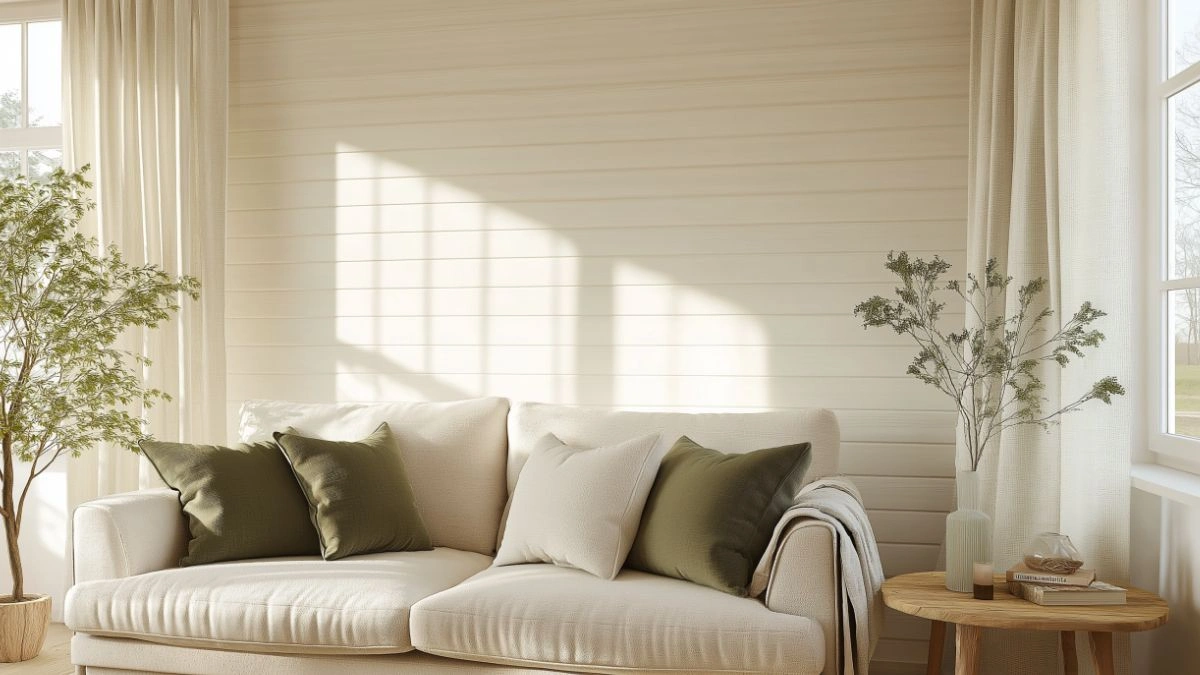Essential Checklist for a Farmhouse Living Room Makeover That Feels Fresh and Timeless
Table of Contents
There’s something undeniably comforting about a farmhouse living room. Rooted in rustic charm but refreshed with modern touches, this style balances warmth, simplicity, and sophistication. In fact, the farmhouse aesthetic has become one of the most popular interior trends over the past decade, and it’s showing no signs of fading.
So what makes the farmhouse living room so appealing? It’s the perfect blend of old and new. Reclaimed wood meets crisp linen, vintage accents play nicely with clean lines, and muted color palettes let textures and materials shine. Whether you live in the countryside or a city apartment, this design style can be tailored to your lifestyle and space.
If you’re dreaming of a cozy yet refined makeover, this checklist-style guide breaks down everything you need to transform your living room into a farmhouse-inspired haven. From foundational elements like furniture and flooring to finishing touches like throw pillows and decorative trays, each section is packed with practical tips and design inspiration to make your vision a reality.
Start with the Right Color Palette
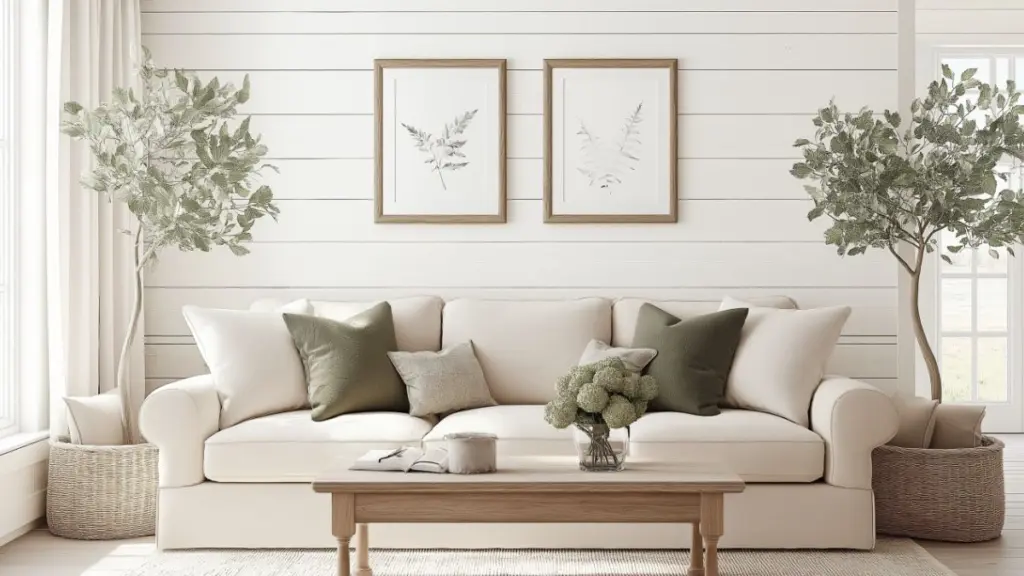
Color is the foundation of any successful farmhouse living room makeover. To capture that inviting and calming vibe, start with a neutral base. Whites, soft creams, taupes, and warm grays are the go-to choices that reflect natural light and make the room feel airy and open.
Accent colors should feel earthy and subdued. Think sage green, muted navy, soft terracotta, and pale mustard. These hues work beautifully with natural textures and vintage decor pieces. If you love contrast, consider incorporating black accents sparingly—think window frames, hardware, or industrial lighting.
Use your color palette consistently across paint, textiles, and accessories to ensure a cohesive feel. A white shiplap wall pairs beautifully with beige upholstery and charcoal accents for a balanced farmhouse look.
Farmhouse Color Palette Essentials
| Color Type | Recommended Tones | Where to Use |
|---|---|---|
| Base Colors | Warm white, cream, soft gray | Walls, sofas, large furniture |
| Accent Colors | Sage green, dusty blue, terracotta | Throw pillows, rugs, artwork |
| Contrasts | Matte black, rustic bronze | Light fixtures, frames, cabinet pulls |
Choose Farmhouse Furniture with Purpose
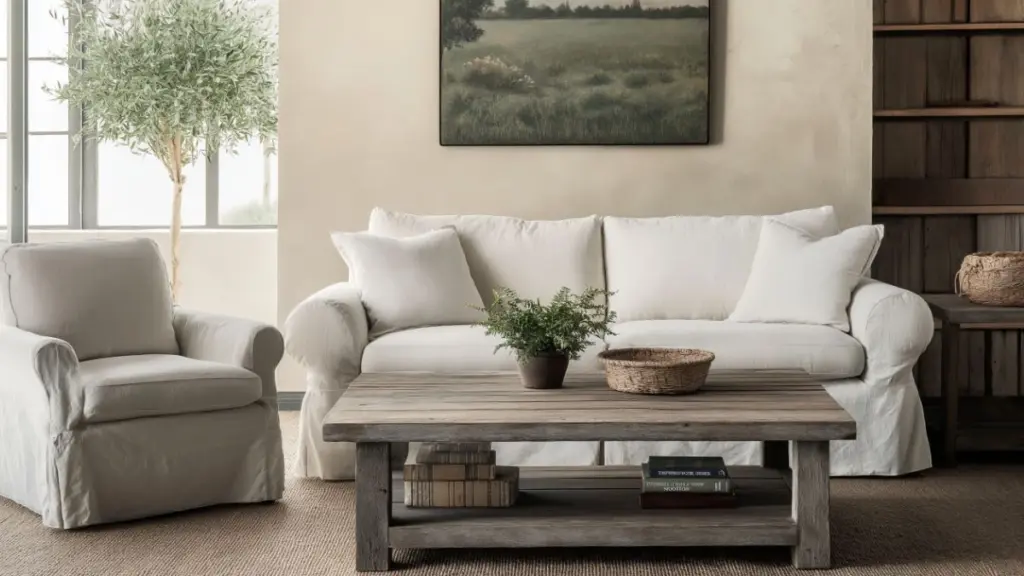
Farmhouse-style furniture isn’t just about looks—it’s about practicality and comfort. Choose pieces that feel welcoming, slightly worn-in, and crafted from sturdy materials. The goal is to create a space where people want to linger.
Start with a generously sized sofa in a neutral linen or cotton fabric. Sectionals work great in larger spaces, while a cozy loveseat and two armchairs suit more compact layouts. Opt for roll arms, slipcovers, or tufted cushions for that quintessential farmhouse softness.
Wood furniture should show some character. Look for pieces with distressed finishes, reclaimed wood, or rough-hewn textures. A classic farmhouse coffee table—often a plank-style or X-base design—grounds the room with rustic flair. Side tables, media consoles, and shelving units in similar finishes will tie everything together.
Don’t be afraid to mix old and new. Pair a modern console with a vintage trunk as a side table. The contrast adds depth and authenticity to your design.
Farmhouse Furniture Checklist
| Furniture Item | Farmhouse Style Tips |
|---|---|
| Sofa | Linen slipcover, tufted cushions, neutral tone |
| Coffee Table | Reclaimed wood, cross-leg base |
| Side Tables | Mismatched or vintage with wood or metal |
| Storage Pieces | Open shelving, weathered console |
| Seating Extras | Woven bench, leather pouf, cane-back chair |
Incorporate Natural Materials and Textures
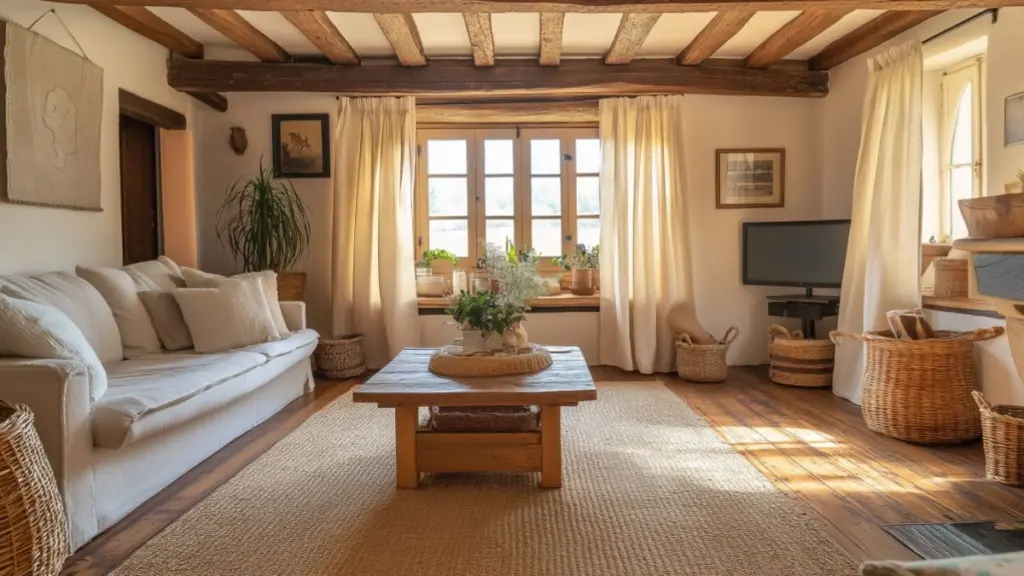
One of the signature characteristics of farmhouse decor is its love for raw, tactile materials. These textures create depth and warmth, especially in an open, neutral-toned room.
Wood is the star of the show—used in flooring, beams, tables, and even ceiling treatments. Opt for wide-plank hardwood or wood-look tile in warm or weathered tones. Layer in stone, brick, or shiplap as architectural accents to enhance rustic charm.
Next, bring in textiles that feel cozy and durable. Think chunky knit throws, soft wool rugs, and cotton or linen curtains. A jute or braided rug grounds the space and contrasts beautifully with smooth leather or upholstery.
Metal elements should feel aged or industrial. Use black iron, brushed bronze, or galvanized finishes for lighting, curtain rods, and hardware. Wicker baskets, woven trays, and ceramic vases provide both function and organic appeal.
Natural Texture Guide
| Material | Best Use Cases |
|---|---|
| Reclaimed Wood | Coffee tables, consoles, wall accents |
| Linen & Cotton | Pillows, slipcovers, curtains |
| Wicker & Rattan | Baskets, light fixtures, side tables |
| Metal | Light fixtures, shelving brackets, accents |
| Stone & Brick | Fireplace surrounds, feature walls |
Add Vintage and Antique-Inspired Touches
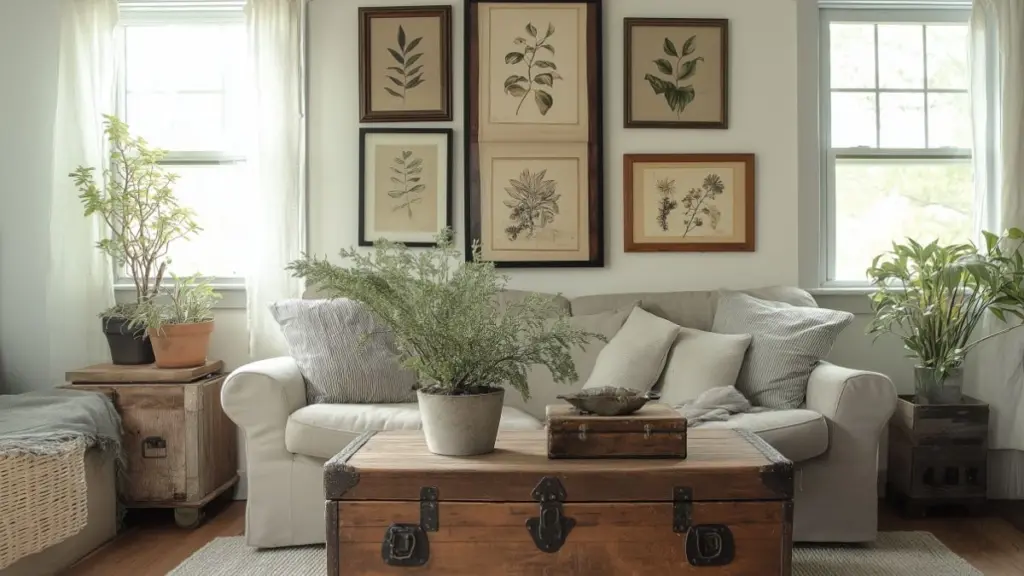
A farmhouse living room isn’t complete without a few nods to the past. Vintage finds give your space soul and character. From weathered trunks to salvaged signs, these items tell stories and bring balance to newer elements.
Visit local antique shops or flea markets to find pieces with patina. Look for old mirrors, framed botanical prints, or distressed wooden frames. Incorporate a vintage ladder as a blanket holder, or repurpose a salvaged window as wall decor.
Mix these treasures sparingly with your more polished pieces to avoid a cluttered look. One or two antique focal points will feel intentional rather than overwhelming.
Vintage Decor Ideas
| Item Type | Placement Idea |
|---|---|
| Old Trunk | Coffee table or foot-of-sofa storage |
| Framed Botanical Art | Gallery wall or above console table |
| Wooden Ladder | Blanket holder near fireplace |
| Salvaged Window | Hung as wall decor behind sofa |
Curate Comfortable and Layered Textiles
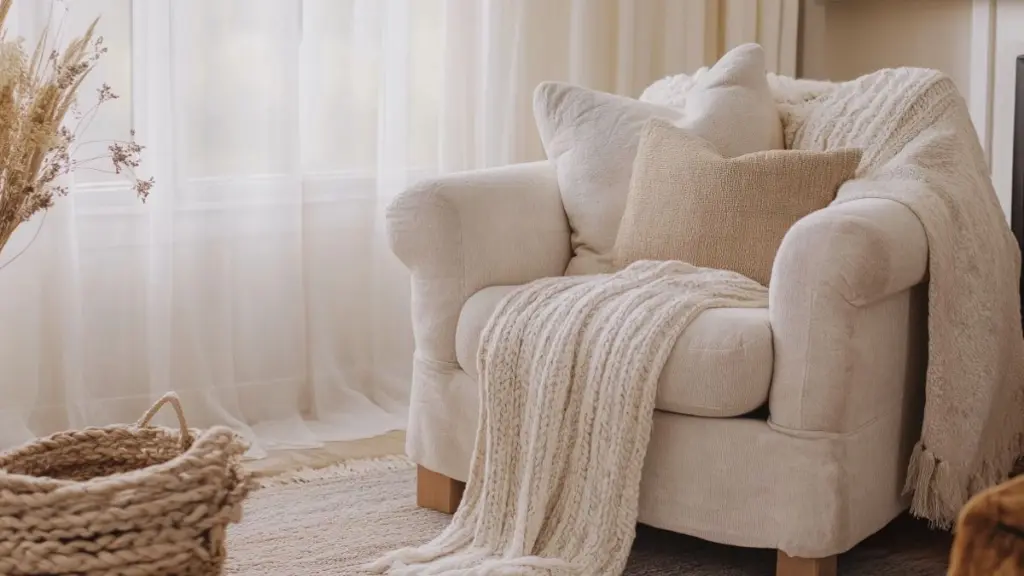
Textiles are essential to creating that “lived-in” farmhouse feel. They soften the space and invite you to kick off your shoes and relax.
Start with throw pillows—mixing solids, stripes, checks, and florals in muted tones. Use a combination of textures like linen, velvet, and embroidery for a curated, cozy effect. Keep the color palette tight to maintain cohesion.
Layer throws over the sofa and accent chairs. Chunky knit or tasseled blankets add warmth and seasonal flair. A large area rug grounds the space—look for flatweave, Persian-style, or natural fiber rugs to enhance visual interest.
Curtains should feel breezy and unfussy. Opt for soft cotton or linen panels in light hues that frame windows without overpowering them.
Farmhouse Textile Checklist
| Textile Type | Style Tip |
|---|---|
| Throw Pillows | Mix materials and patterns in 2–3 colors |
| Blankets & Throws | Keep on chairs, sofas, and benches |
| Area Rug | Anchor seating zone, add warmth |
| Curtains | Simple linen or cotton, ceiling-height hang |
Decorate with Purposeful Accessories
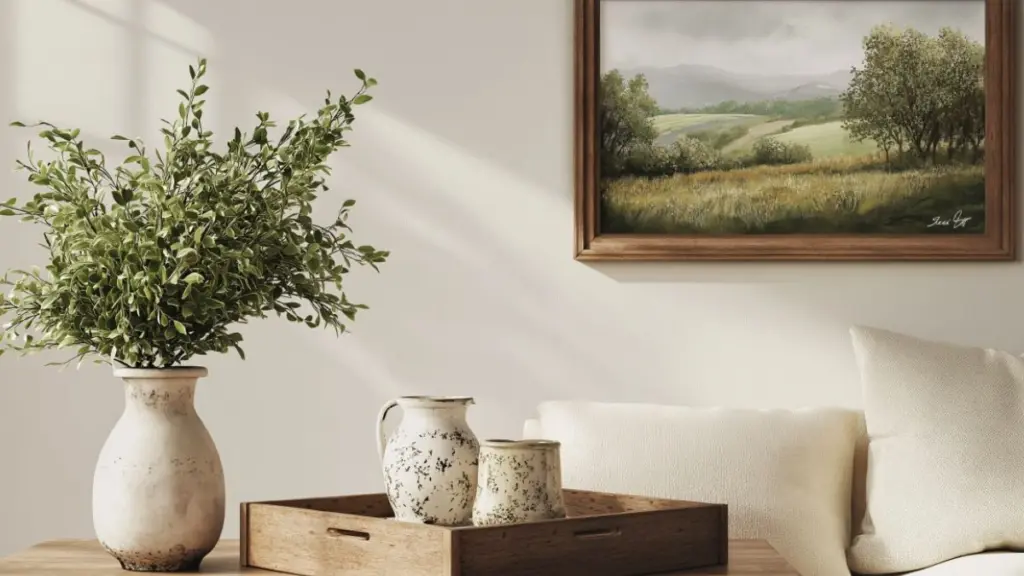
Accessories complete your farmhouse living room but should never overwhelm it. Think quality over quantity—each piece should serve a visual or practical purpose.
Start with a few coffee table staples: a ceramic vase, a wooden tray, stacked books, or a seasonal candle. Use open shelving to showcase items like heirloom china, framed photos, or pottery in soft neutrals.
Hang wall art with intention. A large-scale sign with a simple quote, black-and-white photography, or farmhouse-style landscapes help tie the room together. Avoid over-decorating—blank wall space can be just as impactful.
Include greenery with real or faux plants. Olive trees, eucalyptus stems, and potted herbs are perfect low-maintenance options for adding life to the room.
Accessory Must-Haves
| Item Type | Best Placement |
|---|---|
| Wooden Tray | Coffee table or ottoman |
| Vases & Planters | Console, open shelves, side tables |
| Framed Art | Above sofa, fireplace, or entry wall |
| Greenery | Corners, tabletops, shelves |
Conclusion
A farmhouse living room makeover is as much about feeling as it is about function. With the right balance of natural textures, timeless furniture, vintage details, and cozy accessories, your space can become a warm, inviting retreat that feels both current and classic.
By following this essential checklist, you’ll have a roadmap to guide your design journey. Whether you’re updating just a few pieces or doing a full transformation, each choice you make brings you one step closer to a space that reflects your unique style and offers everyday comfort.

